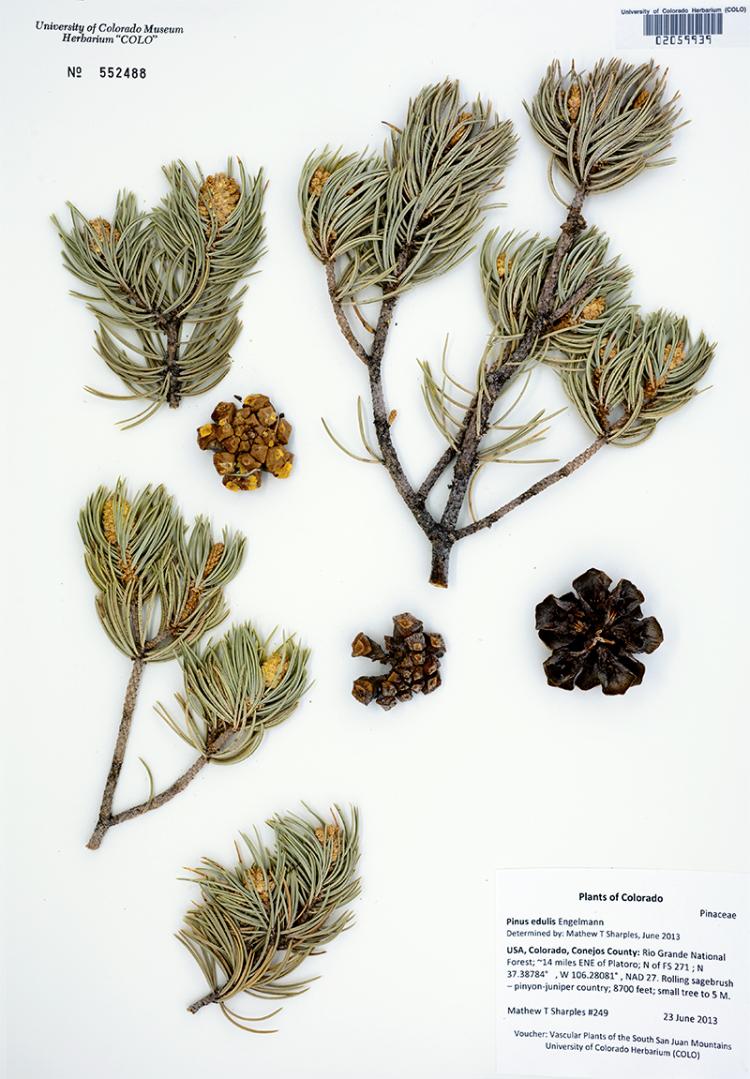The CU Museum is closed until January 8, 2026.
During this time, collection visits will be available by appointment and other special access requests will be considered on a case-by-case basis.
Please email cumuseum@colorado.edu for more information.
Piñon Pine

The seeds of the piñon are a rich source of protein and fats, providing a bounty for small mammals and breeding birds, and serves a keystone role in the structuring of a myriad of ecological relationships. Pinus edulis doesn’t come to sexual maturity until 75 to 100 years of age, but begin producing cones as early as 35 years, and the cones that house their seeds often don’t reach full ripeness until 3 years into their growth cycle1. Deer, bear, and desert bighorn sheep thrive on the pine nuts, as do birds in the corvid family such as Stellar’s and Piñon jays as well as Clark’s nutcrackers. The Piñon jay offers a special symbiosis, a mutually beneficial relationship, with the pinyon pine, as these birds help disperse seeds found in their cones to help propagate the tree. These seeds don’t solely offer sustenance to wildlife but humankind as well.
Native peoples, going back to the earliest pueblo cultures, were sustained by this complex ecosystem, with the Piñon pine’s seeds offering a hardy source of protein and fats. According to the USDA, a cup of pine nuts, the colloquial term for the seeds of the piñon pine, accounts for over 900 calories and 18 grams of protein, roughly a third of our daily value for caloric intake. Native peoples assuredly used these nutritionally valuable seeds for sustenance but also fashioned rope and cord from juniper and piñon bark, and roof beams for their houses3. Pinus edulis provided a staple food, along with other vegetation in the area, to Indigenous people both in the past and present. Unfortunately, in recent decades, both the U.S. Forest Service and the Bureau of Land Management have destroyed large tracts of p-j woodlands across North America through the use of ‘chaining,’ a destructive means of clearing land by the use of two bulldozers with an heavy chain strung between them, as a government subsidy to the livestock industry2.
The loss of wild nature is a profound and disheartening affront to the spirit of people everywhere. There are values to be found in the unspoiled grasslands, woodlands, and forests beyond any price. For those familiar with the native cultures of New Mexico and southern Colorado, there are few things more precious than the scent of roasting pine nuts over a pinon fire on a chill autumn morning.
1. Anderson, M. (2002). Pinus edulis. In: Fire Effects Information System, [Online]. U.S. Department of Agriculture, Forest Service, Rocky Mountain Research Station, Fire Sciences Laboratory.
2. Timbimboo-Madsen, P. (2011). 018-Native American Uses of Utah Forest Trees. Utah State University, Forestry Division.
3. Shellbach, L. (1933). Grand Canyon Nature Notes, [Online]. Grand Canyon National Park. http://npshistory.com/nature_notes/grca/vol8-9c.htm

